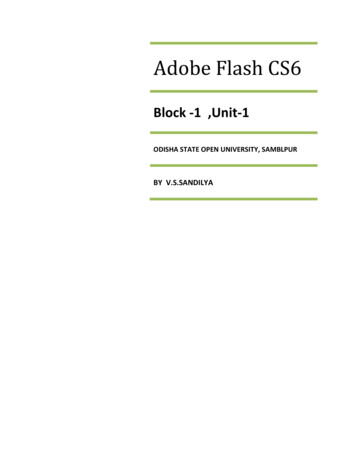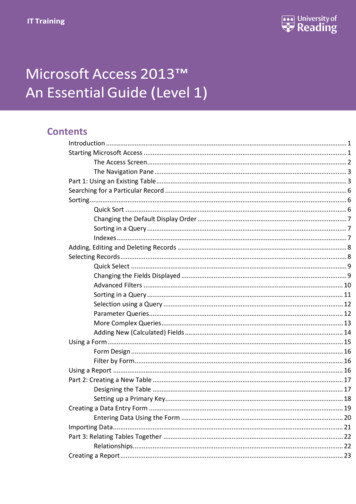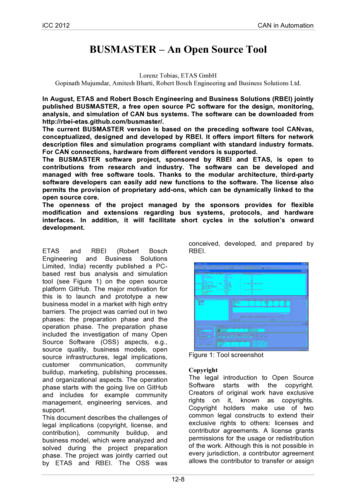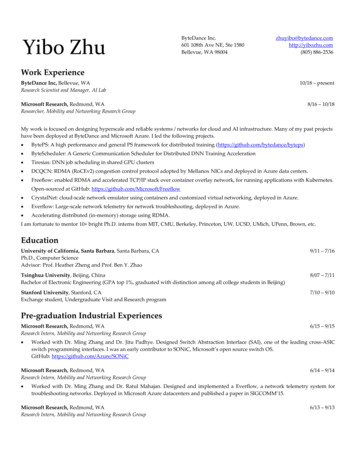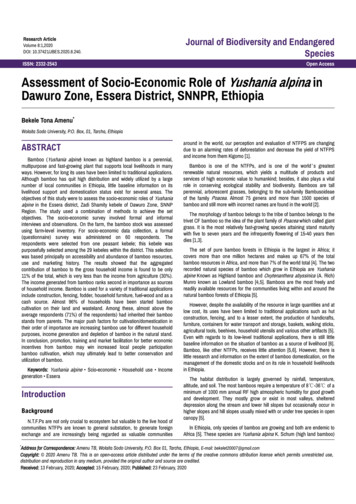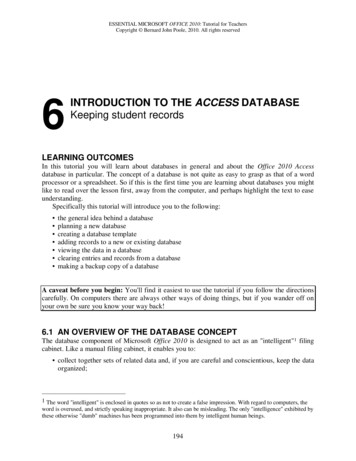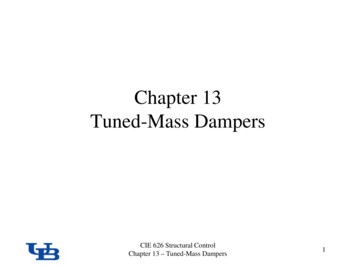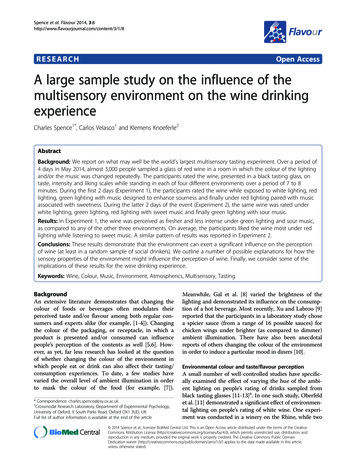
Transcription
Spence et al. Flavour 2014, ARCHOpen AccessA large sample study on the influence of themultisensory environment on the wine drinkingexperienceCharles Spence1*, Carlos Velasco1 and Klemens Knoeferle2AbstractBackground: We report on what may well be the world’s largest multisensory tasting experiment. Over a period of4 days in May 2014, almost 3,000 people sampled a glass of red wine in a room in which the colour of the lightingand/or the music was changed repeatedly. The participants rated the wine, presented in a black tasting glass, ontaste, intensity and liking scales while standing in each of four different environments over a period of 7 to 8minutes. During the first 2 days (Experiment 1), the participants rated the wine while exposed to white lighting, redlighting, green lighting with music designed to enhance sourness and finally under red lighting paired with musicassociated with sweetness. During the latter 2 days of the event (Experiment 2), the same wine was rated underwhite lighting, green lighting, red lighting with sweet music and finally green lighting with sour music.Results: In Experiment 1, the wine was perceived as fresher and less intense under green lighting and sour music,as compared to any of the other three environments. On average, the participants liked the wine most under redlighting while listening to sweet music. A similar pattern of results was reported in Experiment 2.Conclusions: These results demonstrate that the environment can exert a significant influence on the perceptionof wine (at least in a random sample of social drinkers). We outline a number of possible explanations for how thesensory properties of the environment might influence the perception of wine. Finally, we consider some of theimplications of these results for the wine drinking experience.Keywords: Wine, Colour, Music, Environment, Atmospherics, Multisensory, TastingBackgroundAn extensive literature demonstrates that changing thecolour of foods or beverages often modulates theirperceived taste and/or flavour among both regular consumers and experts alike (for example, [1-4]). Changingthe colour of the packaging, or receptacle, in which aproduct is presented and/or consumed can influencepeople’s perception of the contents as well [5,6]. However, as yet, far less research has looked at the questionof whether changing the colour of the environment inwhich people eat or drink can also affect their tasting/consumption experiences. To date, a few studies havevaried the overall level of ambient illumination in orderto mask the colour of the food (for example, [7]).* Correspondence: charles.spence@psy.ox.ac.uk1Crossmodal Research Laboratory, Department of Experimental Psychology,University of Oxford, 9 South Parks Road, Oxford OX1 3UD, UKFull list of author information is available at the end of the articleMeanwhile, Gal et al. [8] varied the brightness of thelighting and demonstrated its influence on the consumption of a hot beverage. Most recently, Xu and Labroo [9]reported that the participants in a laboratory study chosea spicier sauce (from a range of 16 possible sauces) forchicken wings under brighter (as compared to dimmer)ambient illumination. There have also been anecdotalreports of others changing the colour of the environmentin order to induce a particular mood in diners [10].Environmental colour and taste/flavour perceptionA small number of well-controlled studies have specifically examined the effect of varying the hue of the ambient lighting on people’s rating of drinks sampled fromblack tasting glasses [11-13]a. In one such study, Oberfeldet al. [11] demonstrated a significant effect of environmental lighting on people’s rating of white wine. One experiment was conducted in a winery on the Rhine, while two 2014 Spence et al.; licensee BioMed Central Ltd. This is an Open Access article distributed under the terms of the CreativeCommons Attribution License (http://creativecommons.org/licenses/by/4.0), which permits unrestricted use, distribution, andreproduction in any medium, provided the original work is properly credited. The Creative Commons Public DomainDedication waiver ) applies to the data made available in this article,unless otherwise stated.
Spence et al. Flavour 2014, ow-up studies were conducted back in the psychologylab. Changing the colour of the lighting (white, red, greenor blue) exerted a significant effect on people’s responses tothe wine in each and every experiment. That said, nature ofthat change was not altogether consistent from oneexperiment to the next.In Oberfeld et al. [11] first experiment (conducted inthe winery), people rated a Riesling white wine as significantly more pleasant and said that they would paysignificantly more for a bottle of the wine under the redlighting (than under any of the other three lightingcolours). In a second study, this time conducted in thepsychology laboratory, the same red lighting resulted inthe white wine being rated as less spicy (as compared towhen the same wine was rated while under blue or greenlighting) and less fruity (as compared to green and whitelighting). Interestingly, no significant effect on the perceived value of the wine was obtained on this occasionb.In a third experiment, the wine was rated as tastingfruitier under the red lighting as compared to when itwas evaluated under blue lighting. The wine also tastedsweeter under the red lighting as compared to blue orwhite lighting [13,14]. While these results are undoubtedly intriguing, it is worth noting that earlier studies inthis area (for example, [12]) found no such effect ofchanges in the ambient lighting on people’s perceptionof wine. Given the mixed results that have been published in the literature [14,15], it seemed sensible to tryand resolve once and for all the question of whetherchanging the hue of the ambient lighting would changethe way in which social drinkers rate wine.The ambient lighting colours used in the present studywere selected on the basis of Oberfeld et al. [11], as wellas on the basis of a pre-test of various light colours priorto the main data collection event (reported below).Given the within-participants nature of this public event,and the fact that the whole experience was designed tolast no more than 7 or 8 minutes, we were unable to testa wide range of ambient colours. Red and green seemedappropriate given the natural associations that exist between green and unripe (that is, sour and possibly bitter)fruits and red and ripe (that is, sweet) fruits [16-21].Background music and taste/flavour perceptionBeyond any impact of changing the hue of the ambientlighting (white, red or green) on people’s perception of aglass of (red) wine, as tasted from a black tasting glass,we were also interested in any additional effect that varying the musical environment might have on the participants’ wine tasting experience. A spate of recent studieshave demonstrated that simply by changing the musicplaying in the background one can effectively changehow people rate the taste of a drink or food, and/or howmuch they enjoy the overall experience (see [22-27]).Page 2 of 12Extending this line of research, we wanted to knowwhether playing short musical selections during the winetasting would have any additional influence on participants’ judgements over-and-above that elicited by changing the lighting. To this end, we complemented someof the lighting conditions with recently-generated (andtested) musical selections that have been shown to beassociated in the general population with sour or sweettastes (Knoeferle KM, Woods A, Käppler F, Spence C:That sounds sweet: Using crossmodal correspondencesto communicate gustatory attributes. Psychol Market,submitted).Note that, to date, the majority of studies have eitherlooked only at the effects of changing the ambient lightingor only at the presentation of various background music/soundscapes, but never at the two together. Two possiblekinds of result might be predicted given the literature onmultisensory perception [28,29]: on the one hand, anadditive or possibly even superadditive effect (that is, aneffect that is bigger than one would expect simply bycombining the effect of each cue when presented individually) of combining congruent visual and auditory environmental cues might be obtained [30,31]. On the otherhand, however, one might also legitimately expect to findthat vision was dominant, given our status as essentiallyvisually-dominant creatures (for example, [32,33]), andhence the addition of background sound might not haveany effect over and above that attributable to the lighting.Study objectivesIn the present study, we followed up on Oberfeld et al.’s[11] intriguing findings with a much larger sample.More specifically, we collected data from almost 3,000participants as compared to 200 in the largest of Oberfeldet al. three experiment. The study, presented to membersof the public as The Colour Lab, was conducted over aperiod of four successive days at the start of May 2014,in a central London location (under The SouthbankCentre). We used a within-participants experimentaldesign. The order in which the various environmentalconditions were presented was different on the first 2days, as compared to the last 2 days. For ease of analysisand presentation, though, the results collected on thefirst 2 days are treated as Experiment 1, while the resultsfrom the latter 2 days are treated as Experiment 2. In allregards except for the order and exact nature of theenvironmental conditions presented to the participants,these two studies were identical. Specifically, in Experiment 1, the environmental conditions consisted of whitelighting, red lighting, green lighting with sour musicand red lighting with sweet music. In Experiment 2, theconditions consisted of white lighting, green lighting,red lighting with sweet music and green lighting withsour music.
Spence et al. Flavour 2014, 3:8http://www.flavourjournal.com/content/3/1/8Page 3 of 12Experiment 1Methods and materialsA total of 1,580 participants (871 women, 643 men and66 who failed to specify) aged 18 to 90 years (M 34.3,SD 11.9) agreed to take part in The Colour Lab after theprocedure had been explained to them. The experimentwas reviewed and approved by the Central UniversityResearch Ethics Committee of the University of Oxford(reference number: MSD-IDREC-C1-2013-074), and complied with the Helsinki Declaration. Because the experimentwas conducted through a public event, the participants didnot sign a consent form; however, the purpose of the studyand the experimental procedure were explained, and onlythe participants who agreed to participate were offered aplace in the event. Any questions that the participants hadwere answered. The participants were informed that, bytaking part of it, they were subject to having their phototaken and used after the event. Eight percent of the questionnaire ratings were not completed and therefore excluded from the subsequent data analysis.The participants were initially briefly introduced to theart of wine tasting by a trained guide. They were alsogiven a tasting strip sourced from Precision Laboratoriesin order to assess their sensitivity to PTC [34,35]c. Thistest is known to give rise to a wide range of differenttaste experiences: from no sensation at all through toone of extreme bitterness. The tasting strip was used inorder to demonstrate the wide inter-individual variabilitythat exists in the world of taste perception [36]. Thosewho found the tasting strip bitter were offered a glass ofwater to neutralise the taste prior to the wine tasting. Theguide then spent 3 to 4 minutes introducing the wine andthe experience that the participants were about to have.Before entering the main experimental chamber, theparticipants were offered a glass (approximately 100 mL)of Campo Viejo Reserva 2008 (Rioja) in a standard blackISO tasting glass. The wine itself is ruby red in colour,with bright and deep nuances. It features complexaromas with an excellent balance between the fruits(cherries, black plums, ripe blackberries) and the spicescoming from the wood (clove, pepper, vanilla and coconut). The wine is aged in French and American oak andthen in the bottle in the cellar. During this time, the wine’sbouquet develops. The wine is smooth and balanced onthe palate, has a full, elegant feel and a lingering finish.The participants then entered a 14 5 m rectangularroom with white walls, floor and ceiling (Figure 1). Theparticipants entered from one end of the room andexited from the other end.Previous research has suggested that green tends to beassociated with unripe (that is, sour and possibly bitter)fruits and red with ripe (that is, sweet) fruits (for example, [16-21]). Having said that, Experiments 1 and 2included three lighting conditions: red light, green lightFigure 1 Example of the way the lighting looked in the (A) white,(B) red and (C) green colour conditions. The pictures were taken bythe professional photographer Debbie Bragg. All images copyright thephotographer.and white light. The first two were included assumingthat these colours can presumably be associated totaste features such as sweet and sour, and the latter asa control.The sounds used in the present study were taken froma recent study by (Knoeferle KM, Woods A, Käppler F,Spence C: That sounds sweet: Using crossmodal correspondences to communicate gustatory attributes. Psychol Market, submitted). On the basis of a series oflaboratory studies conducted here at Oxford University,we (as well as several other research groups) have beenworking on trying and elucidating those musical featuresthat match certain basic taste properties (see [37], for a
Spence et al. Flavour 2014, ew). Two of the soundtracks resulting from thiswork were then fed into the present study: the sweetsoundtrack was legato, low in auditory roughness andsharpness, and highly consonant. In contrast, the soursoundtrack was staccato, high in roughness and sharpness, and moderately consonant. Both soundtracks usedotherwise identical musical material, consisting of acombination of relatively high-pitched foreground andbackground elements. In the two Western samples(N1 61, N2 309) reported in (Knoeferle KM, WoodsA, Käppler F, Spence C: That sounds sweet: Using crossmodal correspondences to communicate gustatory attributes. Psychol Market, submitted), the recognition ratesfor the sweet music were 57.4% and 61.6%, while recognition rates for the sour music were 34.4% and 33.6%(forced choice matchings of four pieces of music withfour basic tastes - hence chance level performance 25%). The interested reader can download these shortpieces of music at https://soundcloud.com/crossmodal/sets/tastemusic. The musical selections were played at acomfortable listening level from several loudspeakersmounted over the experimental space.Given that we expected the participants to consistmainly of social drinkers, the decision was made tokeep the questionnaire as simple and intuitive as possible - that is, we tried to avoid the use of any winelanguage that some of the participants might not readily understand (Figure 2). Specifically, three 7-pointPage 4 of 12Likert scales were included in the study: one for taste/flavour anchored with ‘fruity’ and ‘fresh’, one for intensity anchored with ‘low’ and ‘high’, and one for likinganchored with ‘not at all’ to ‘very much’. Our choice ofthe fresh/fruity scale was based on a discussion withone of the wine-makers for the Campo Viejo brand, andseemed to capture two distinct attributes of the wine.These descriptors were felt to be the ones that the randomsample of participants who were going to take part in thestudy would be able to identify readily. The participantswere taken through the experience in groups of approximately 30 by one of four trained guides.ResultsFollowing a mixed design, a repeated measures analysisof variance (RM-ANOVA) with environment as a withinparticipants factor (four levels: white lighting, red lighting,green lighting with sour music, and red lighting with sweetmusic) and gender as a between-participants factord, wasconducted on each of the three different attributes. Whenever sphericity was violated, Greenhouse-Geisser corrected values are presented. All pairwise comparisonsreported in the text have been Bonferroni-corrected.Taste (fresh vs. fruity)The analysis revealed a significant main effect of theenvironment on participants’ taste ratings, F(2.902,4146.784) 127.310, P 0.001, η2partial 0.082 (Figure 3A)Figure 2 Score sheet used in the two experiments reported here. This particular score sheet was used on the first 2 days (Experiment 1).The order of the conditions was changed for the latter 2 days (Experiment 2).
Spence et al. Flavour 2014, 3:8http://www.flavourjournal.com/content/3/1/8and a taste by gender interaction, F(3, 4287) 2.764, P 0.04, η2partial 0.002. According to the results of pairwisecomparisons, the participants rated the wine as tasting significantly fresher in the green lighting/sour music environment than in any one of the other three environments (P 0.001 for all comparisons). The wine was also rated astasting significantly fresher under white than under redlighting (no matter whether or not the putatively ‘sweet’Page 5 of 12music was playing in the background; P 0.001 for bothcomparisons). In other words, compared to the white lighting baseline condition, green lighting brought out the wine’sfreshness, while the red lighting brought out the fruitiernotes in the wine. Pairwise comparisons on the interactionterm revealed that the male participants (M 3.44) ratedthe wine as significantly fresher under red lighting than didthe female participants (M 3.27, P 0.046).Figure 3 Mean ratings of taste (A), intensity (B) and liking (C) in Experiment 1. The error bars represent the standard error of the means.The thicker line shows the environment being compared and the asterisks mark those comparisons that differed significantly (P 0.05).
Spence et al. Flavour 2014, our intensityThere were significant main effects of the environment, F(2.970, 4309.665) 31.342, P 0.001, η2partial 0.021 (Figure 3B) and gender, F(1, 1451) 4.448, P 0.035,η2partial 0.003, on participants’ flavour intensity ratings.Pairwise comparisons revealed that the wine was rated astasting significantly less intense in the green lighting/sourmusic environment than any of the other environments (P 0.001, for all comparisons). In addition, the female participants (M 4.58) tended to rate the wine as more intense than did the male participants (M 4.47, P 0.035).LikingAnalysis of participants’ liking ratings (Figure 3C) revealed significant main effects of environment, F(2.938,4251.669) 29.114, P 0.001, η2partial 0.005, and gender,F(1, 1447) 12.225, P 0.001, η2partial 0.008. Accordingto the results of pairwise comparisons, the wine was likedmore under red lighting combined with sweet music thanany of the other environments (P 0.001). Furthermore,the participants also liked the wine significantly moreunder red lighting and white lighting than under greenlighting combined with sour music (P 0.001). Pairwisecomparisons revealed that the male participants liked thewine significantly more than did the female participants(M 4.55 vs. 4.33, respectively, P 0.001).DiscussionThe results of Experiment 1 clearly demonstrate that thesensory attributes of the environment in which peopletaste a wine can indeed exert a significant influence overtheir ratings (and hence also presumably on their perception) of red wine (though see [38]). While tastesundoubtedly differ [36,39], the general finding to emergefrom this first study is that the majority of the randomsample of participants (primarily social drinkers) preferredthe red wine (a Rioja) under red lighting while listening tosweet music than in any of the other three environmentalconditions. That said, the addition of the sweet musiconly had an effect on liking ratings. (We return to a fullerdiscussion of this point in the General Discussion.)Perhaps the key result to emerge from the analysis ofthe data from Experiment 1 is that of the more than1,500 people who tried the red wine under the fouratmospheric conditions, the general preference for thewine was when tasted under red ambient lighting whilelistening to the putatively sweet music. It is, however,important to bear in mind here that the participants inExperiment 1 experienced the four atmospheres in thesame order (white lighting, red lighting, green lightingwith sour music, and finally, red lighting with sweetmusic). Hence, the possibility cannot be ruled out thatthere might be some sort of order effects lurking in thedata. Consequently, in order to address this particularPage 6 of 12concern we changed the order in which the colour/lightenvironments were presented in Experiment 2 (conductedon the second 2 days of The Colour Lab).Experiment 2Methods and materialsA total of 1,309 participants (719 women, 570 men and20 who failed to specify) aged 18 to 84 years (M 35.4,SD 11.9) took part in Experiment 2. Once again, 8% ofthe questionnaire ratings were not completed and as aconsequence were excluded from the analysis. The designof Experiment 2 was identical to that of Experiment 1 withthe sole exception that the four environments in whichthe participants rated the wine were as follows: whitelighting, green lighting, red lighting with sweet music,and, finally, green lighting with sour music. The analyseswere performed exactly as set out in Experiment 1.ResultsTaste (fresh vs. fruity)Once again, there was a significant main effect of the environment on participants’ ratings, F(2.891, 3569.892) 26.386, P 0.001, η2partial 0.021 (Figure 4A). Pairwisecomparisons revealed that the participants rated the wineas fresher when evaluated under green light/sour music,as compared to the other environments (P 0.001), and asfresher under white light as compared to red light andsweet music (P 0.001). These results are consistent withthose of Experiment 1.Flavour intensityThere were significant main effects of environment(F(2.951, 3685.723) 32.829, P 0.001, η2partial 0.026)(Figure 4B) and gender (F(1, 1249) 6.435, P 0.011,η2partial 0.005). Pairwise comparisons revealed thatthe wine was rated as tasting significantly more intense under white lighting and red lighting withsweet music, as compared to green lighting alone andwhen paired with the sour music (P 0.001, for all comparisons). The participants also rated the wine as more intense under green lighting as compared to green lightingand sour music (P 0.011). Additionally, the female participants rated the wine as tasting more intense overallthan did the male participants (M 4.60 vs. 4.46, respectively; P 0.011). The patterns of results for intensity arenumerically very similar to those reported in Experiment 1 (compare Figures 3B and 4B).LikingAnalysis of the participants’ liking ratings revealed significant main effects of environment (F(2.933, 3672.711) 49.204, P 0.001, η2partial 0.038) (Figure 4C) and gender(F(1, 1252) 10.664, P 0.001, η2partial 0.008), as well asa significant interaction term (F(2.933, 3672.711) 3.883,
Spence et al. Flavour 2014, 3:8http://www.flavourjournal.com/content/3/1/8Page 7 of 12Figure 4 Mean ratings of taste (A), intensity (B) and liking (C) in Experiment 2. The error bars represent the standard error of the means.The thicker line shows the environment being compared and the asterisks mark those comparisons that differed significantly (P 0.05).P 0.009, η2partial 0.003). Pairwise comparisons revealedthat the wine was liked significantly more when rated inthe red lighting/sweet music environment, as compared toany of the other environment (all Ps 0.001). The participants also liked the wine more under white light thanunder green lighting no matter whether the sour musicwas playing (P 0.001). Pairwise comparisons revealed asignificant gender difference with the male participantsonce again tending to like the wine more than the femaleparticipants (M 4.57 vs. 4.36, respectively; P 0.001).Post-hoc analysis of the gender by environment interaction revealed that men liked the wine more than did thewomen in under white light (P 0.001), red light (P 0.005) and green light/sour music (P 0.023).
Spence et al. Flavour 2014, all, the results of Experiment 2 replicate the findings of Experiment 1 in showing that, on average, theparticipants liked the wine significantly more under redlighting when paired with sweet music than in any of theother three environmental conditions.General discussionThe results of the two experiments reported here provide empirical support for Oberfeld et al. [11] claimthat the colour of the environment can influence people’s(social drinkers in both studies) wine tasting experience.In particular, our results demonstrate that the red wine(a Campo Viejo Reserva 2008) was perceived as significantly fresher and less intense under green lighting, ascompared to either red or white lighting. In both of theexperiments reported here, the red lighting tended tobring out the fruitiness (as compared to the freshness) ofthe red wine. Perhaps most importantly, the participantsliked the wine most under the red lighting while listeningto the sweet music in both experiments. Taken together,these results demonstrate that the environment in which awine is tasted can indeed exert a significant influence onthe perception of wine (at least as indicated by the ratingsof a random sample of social drinkers)e.To give an idea of the magnitude of the change in ratings that were attributable to the change of environment,the results reported here reveal a maximum increase of0.6 points in a 7-point liking scale (or a 9% change) whenimmersed in red lighting, with ‘sweet’ sounding musicplaying. People found the wine noticeably fresher and lessintense when tasted under green lighting with ‘sour’ musicplaying in the background. The increase in freshnessequated to a 1-point (or 14%) change, and the decreasein intensity 0.6 points (a 9% drop), respectively, on the7-point rating scales.Explaining the impact of the environment on the winedrinking experienceHaving demonstrated that the visual, and to a lesserextent the auditory, attributes of the environment canaffect the rating of wine by a random sample of socialdrinkers, the question then arises as to what the mechanism mediating these effects might be. One possibilityhere is that changes in ambient lighting, and/or changesin the background sounds can elicit a change in salivation. Any such change might, in turn, be expected toaffect the taste of the wine [40]. However, such an overtorienting account [41] would seem unlikely given thatone of the only studies to have directly assessed the impact of environmental lighting and sound on salivatoryflow [42] failed to document any significant effect ofchanging the lighting from bluish-white to red, or presenting the sound of wailing sirens, kitchen noises andconversation, or silence on salivatory flow ratesf.Page 8 of 12Another potential mediator of the cross-modal effectof the atmosphere on the wine tasting experience mightbe the meaning and any associations conveyed by differentlighting colours (or types of music). In many contexts,the colour red signals negative valence, danger/loss, andhas been linked to avoidance behaviour in humans [43].Green, by contrast, has been associated with positivevalence, gains and approach behaviour. According to suchan account, it might seem surprising that red lighting ledto the highest liking ratings for the wine sampled in thepresent study (see also [44,45], for suppressive effects ofred on consumption/usage).It would, however, seem reasonable to assume thatenvironmental colour may be interpreted differentlydepending on the particular situational context (for example, [46]): While red and green may generally serve ascues for negative and positive valence, respectively, contextspecific colour associations are likely to supersede suchgeneral associations in food consumption settings [47].Specifically, during food consumption, individuals maydraw upon red and green colours as indicators of likelytaste and flavour based on learned associations betweenfood colours and specific tastes. So, for example, rednessin fruit typically signals ripeness and a sweet taste,whereas a green colour typically indicates unripeand/or sour (and possibly bitter) fruits and vegetables[4,16-19,21]. Red is obviously also a very successfulcolour in the soft drinks aisle (think of Coca-Cola red).Such cross-modal correspondences between basic tastesand flavours on the one hand, and colours, sounds, shapesand so on on the other have become a rapidly growingarea of interest for many researchers and marketers[19,48-50]g.As for the background music, it is worth mentioningthat that sharpness and roughness are inversely relatedto sensory pleasantness [51]. Hence, it is worth notingthat the ‘sour’ music is likely to have been perceived asless pleasant than the ‘sweet’ music, at least based on thepredictions of psychoacoustic models of pleasantness. Assuch, one could imagine a kind of ‘sensation transference’ effect [52-55] from people’s feelings about themusic (that is, like vs. dislike, or like less) carrying overto influence their ratings of how much they liked thewine. Importantly, such as account is based on the basicresponse to the music rather than necessarily any fit between the music and the lighting. It should also be notedthat the ‘sour’ music use
white lighting, green lighting, red lighting with sweet music and finally green lighting with sour music. Results: In Experiment 1, the wine was perceived as fresher and less intense under green lighting and sour music, as compared to any of the other three environments. O

